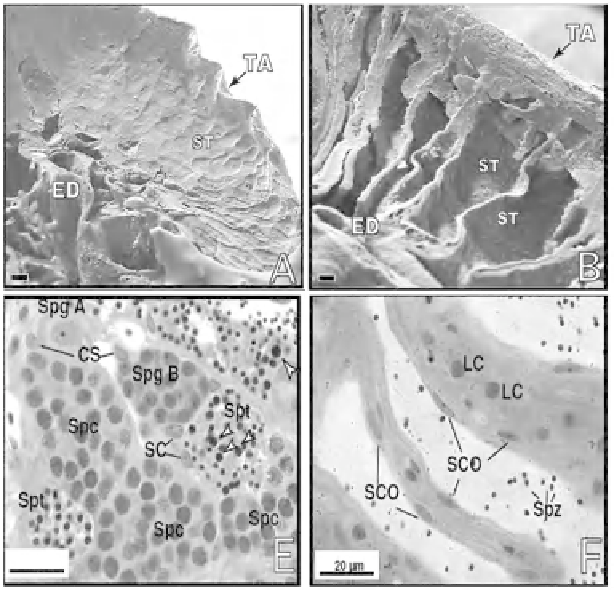Biology Reference
In-Depth Information
20 μm
20 μm
Fig. 41.
Transverse sections of the matured testis of
Oreochromis niloticus.
A and B are scanning
electron microscopic views of (A) fertile and (B) sterile testes. Light microscopic views showing
the spermatogonial cysts in different phases of development in (E) fertile and (F) sterile testes.
TA = tunica albuginea, ED = efferent tuctules, ST = seminiferous tubules, spg A and B = types
of spermatogonia, spc = spermatocytes, spt = spermatids, SC = Sertoli cells, LC = Leydic cells.
SCO = Sertoli cells only, Spz = sperm (from Lacerda et al., 2006)
2003). Further, there are also other similarities; for instance,
Dmrt1
expression
is limited only to spermatogonia and spermatocytes in both the secondary
gonochoric zebrafi sh (Guo et al., 2005) and protogynous sequential
E. akaara
(Xia et al., 2007).
It is likely then that in the protogynous hermaphrodites
too, the transformation of 'adult sex change' is facilitated by the bipotential
germ cell supporting somatic cells. It remains to be seen whether this pattern
of 'juvenile sex change' observed among the secondary gonochores is also
in operation in 'adult sex change' of protogynous hermaphrodites.
The damselfi sh genus
Dascyllus
(Pomacentridae) comprises of both
gonochoric and protogynous species and provides an excellent system
for a study of evolution of protogyny (McCafferty et al., 2002). Not
surprisingly, a series of studies have shown the existence of gonochorism
in
D. trimaculatus
(Asoh and Kasuya, 2002) and
D. albisella
(Asoh et al.,
2001) but protogyny in
D. aruanus
(Cole, 2002),
D. reticulatus
(Schwarz and

